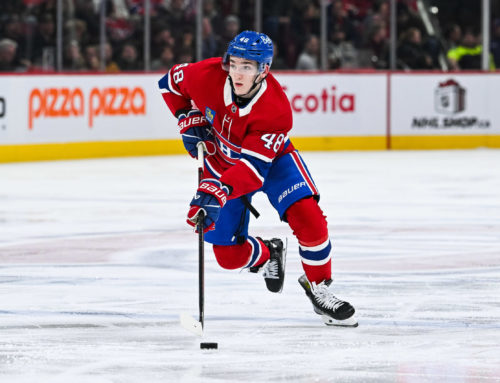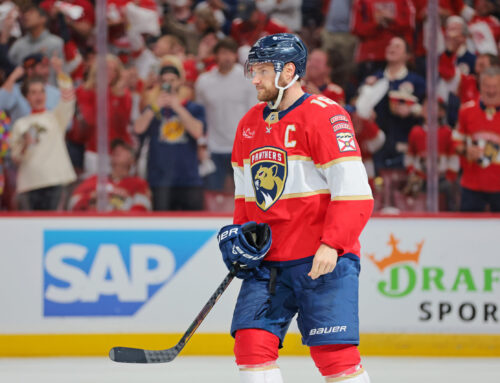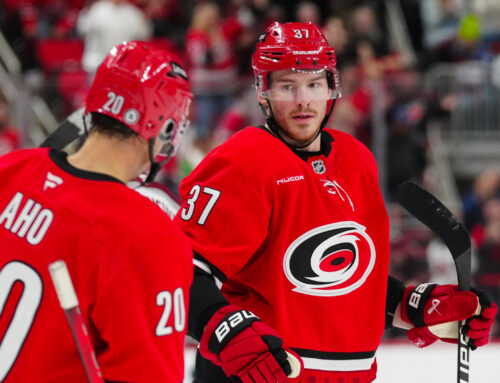Once again I got the call from the ECHL as an EBUG and am filling in for Dobber today. I'm going to focus on a few issues that have either been on my mind for a while or things I'm curious about going forward.
*
First, a big announcement. It's finally launched – the all-new Goalie Post! Be sure to take a look, and you'll have re-sign up for email notifications of any goalie/team you're following for starting goaltending changes. You'll also find the latest Top 100 rankings there.
*
Second, the obligatory Fantasy Guide plug. It's out, for the 17th year, and it's updated. Some of your opponents may have another Guide in hand. You'll have this one. You'll win. It's that simple. Pick it up here.
*
I last did the Ramblings in July of 2021 and talked about my website www.playergameratings.com and my wish to provide game ratings for players and teams. I made the decision at the start of the 2021-22 season to not incorporate an eye-test component so that I could include all 32 teams and the 1,000 players that played last season. I believe at the end of the day, the comparative nature outweighs the increased accuracy of an eye test, which was subjective, to begin with.
My newest pet project within the site is that I've created a google sheet of each team with the player game rating of each player to give an idea of how each team measures up using a projected lineup. I'm hoping to integrate the sheet in the future outside of google sheets or Excel and hyperlink players to the Dobber Frozen Tools. Baby steps. Team PGR Linked 3 Year.xlsx
Important context for the ratings is that 6.41 is the average skater rating and 6.51 for goalies whereas 6.2 to 6.3 is the replacement level. I've also taken game ratings over the past three seasons rather than just last year as I think this gives a more level representation.
Highlighted players in blue are impending UFA.
Here is an example of Toronto:


My plan is to keep these rosters updated in real-time to take into account trades, injuries, call ups etc.
Replacement Level
One of the biggest takeaways I have from the project above is how close NHL players are to each other and I want statistics that represent that to us fans. There are tiers in skill level and production for every position but I think some advanced stats expand the gap between players and present some players at replacement level when they actually aren't.
The definition of replacement level in the NHL should be that of a 7th defenseman or 13th forward who theoretically could be replaced by a player currently playing in the AHL and slotted in with very little difference.
As an example, GAR and WAR are popular advanced stats that show players’ goals above replacement and wins above replacement. Both are derived from a number of categories that contribute to offense, defense and penalties which produce the final number. (from Evolving Hockey). Zero is the replacement level.
We are going to compare four defensemen from the past three seasons combined who are all in the top-four of their respective teams:
From Frozen Tools:

Charlie McAvoy leads this group in GAR over the past three years at 51.3, second in the NHL to Cale Makar. His 51.3 is broken down to 28.0 for offense, 20.2 for defense and 3.1 for penalties.
Chris Tanev is next on the list at 14th in the NHL with a GAR of 30.0, made up of 4.5 for offense, 21.5 for defense and 4.0 for penalties.
Morgan Rielly is 20th in the NHL with a GAR of 24.5 overall, made up of 30.6 for offense, minus 8.1 for defense and 1.9 for penalties. With Rielly on the ice, GAR tells us that his team gave up 8.1 more goals than a replacement defender from the AHL would over three seasons.
Darnell Nurse is 95th in the NHL with a GAR of 10.5 overall, made up of 20.9 for offense, minus 9.9 for defense and minus 0.5 for penalties. With Nurse on the ice, GAR tells us that his team gave up 9.9 more goals than a replacement defender from the AHL would over three seasons.
If my interpretation is oversimplifying the stat, I'm not sure how else to read it. Comments are welcome. The stats from Frozen Tools that stand out for me that boost McAvoy defensively are his plus/minus. Other than hits, blocks, giveaways and takeaways I'm not aware of many measurable defensive stats available publicly.
I was curious as to how my player game ratings had these players over the past three seasons and they have Nurse at 6.66, McAvoy and Rielly tied at 6.6 and Tanev at 6.39.
Tanev is a better player than my ratings but not as good as GAR has him. We both have a ways to go to get more accurate numbers for certain types of players.
Recency Bias
I am guilty of recency bias and I'm sure many others are as well. We like the shiny new model, not the four-year old model that might have some issues. I was looking at the 2018 Entry Draft and even though some of these kids are only 21 and 22 years old, I'm starting to doubt some of the ones that haven't established themselves in the NHL yet on a full-time basis. Will they ever get regular roles?
Looking at the 1st round that year, there are the slam dunks like Rasmus Dahlin, Andrei Svechnikov and Brady Tkachuk who were all taken in the top four picks. There are also question marks like Jesperi Kotkaniemi (3rd), Barrett Hayton (5th), Filip Zadina (6th), Adam Boqvist (8th) and the 13 remaining first round picks who haven't played more than 39 NHL games. If we go to the 2017 class that shrinks to only four players not having 40 games or more and the same number in 2016 and only two for 2015.
It is fairly safe to say that eight or nine of the 13 players from the 2018 draft will start to see regular roles this season or next.
If we look five years after the draft, the likelihood of any drafted player making the NHL on a regular basis is slim.
PTOs
I thought I would look back at the number of players given professional tryouts by teams from 2017 to 2022 and see how many of the players signed on and if so, what were the best seasons each year. (All info from Capfriendly)
2017-18 – 60 players were invited and nine players signed (15%).
Alex Chiasson – Washington – 61-9-9-18
Roman Polak – Toronto – 54-2-10-12
Scottie Upshall – St. Louis – 63-7-12-19
Daniel Winnik – Minnesota – 81-6-17-23
2018-19 – 36 players were invited and seven players signed (19.4%).
Drew Stafford – NJ 59-8-7-15
Alex Chiasson – Edmonton 73-22-16-18
2019-20 – 34 players invited and eight signed (23.5%)
Tobias Rieder – Calgary – 55-4-6-10
Rieder was the only signing to play more than 34 games.
2020-21 – 24 players invited and 17 signed (70.8%)
This was the bubble and teams needed players for the taxi squad.
Michael Del Zotto – Columbus – 53-4-9-13
Andy Greene – NY Islanders – 55-1-4-5
Travis Hamonic – Vancouver – 38-3-7-10
Mike Hoffman – St. Louis – 52-17-19-36
Trevor Lewis – Winnipeg – 56-5-5-10
Riley Sheahan – Buffalo – 53-4-9-13
There wasn't as much time for free agency leading into the bubble, so some of these players would have normally been signed during the off-season and some would have had assurances of being signed before reporting.
2021-22 – 31 players were invited and 11 signed (35.5%)
Brian Boyle – Pittsburgh – 66-11-10-21
Alex Chiasson – Vancouver – 67-13-9-22
Tyler Ennis – Ottawa – 57-8-16-24
Alex Galchenyuk – Arizona – 60-6-15-21
Jimmy Vesey – New Jersey – 66-8-7-15
2022-23 – so far 15 players have received invitations to an NHL training camp and the number will grow over the next two to three weeks.
Notable players are:
Eric Staal – Florida
Derek Stepan – Carolina
Aside from Alex Chiasson who is on this list three times, this is usually a one and done for players reaching the end of their NHL careers. These are true replacement level players.
The significance of these invites and the number of signings each season isn't so much the contribution that the players bring to their new clubs that season, but the opportunity taken away from a younger player who the team feels isn't ready for the NHL yet.
Thanks for reading and if you have any questions or players you'd like me to look at please message or follow me on Twitter @gampbler15.





 EDM
EDM FLA
FLA MIN
MIN DAL
DAL T.B
T.B L.A
L.A CBJ
CBJ S.J
S.J VAN
VAN CHI
CHI DET
DET
